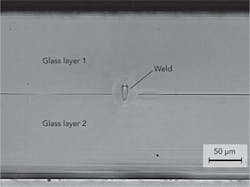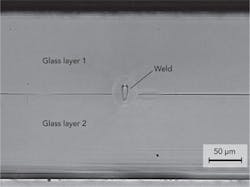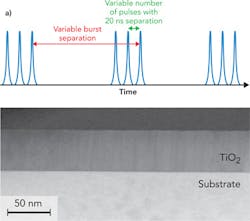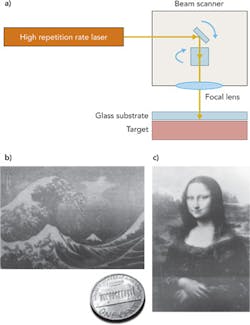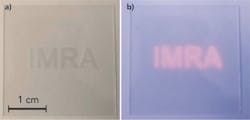Micro-processing with ultrafast fiber lasers
Bing Liu and Alan Arai
Ultrafast fiber lasers are evolving into high-throughput tools for material production
Ultrafast fiber laser technology has progressed quickly in the last decade in terms of total power, pulse and beam quality, compactness, usability, and robustness. As a consequence, ultrafast fiber lasers have emerged as reliable high-throughput tools for high-precision material processing, entering several manufacturing industries. This article summarizes several recent developments in material microprocessing with high pulse repetition rate ultrafast fiber lasers. It is particularly interesting to note that with additional materials studies, new properties and functions are also found in several laser-processed materials, leading to the possibility of ultrafast fiber lasers being used as not only powerful material shaping tools, but also as effective material production tools.
Glass and plastic welding
For most precise material processing applications, heat generation in work pieces other than that required to effect the process is undesirable. However, for micro-welding of transparent materials, precisely controlled localized heat accumulation is essential to melt material and create a welded seam. The high intensity of focused ultrashort pulses induces nonlinear absorption in transparent materials so that significant heating only occurs within a small volume around the laser focus at the buried interface between two materials where the upper material is transparent. Each laser pulse produces a very small amount of heat, which is negligible if the focal volume is allowed to cool before the next pulse arrives. If the pulse-to-pulse spatial overlap and pulse repetition rate is sufficiently high (hundreds of kHz and above) heat can quickly build up locally and cause melting. The amount of melting can be precisely controlled by varying the repetition rate and beam scan speed. This technique has been demonstrated with glass and plastic welding. FIGURE 1 shows the cross-section of a welded interface between two pieces of glasses. A sealant- free high-speed precise welding like this can benefit, for example, solar panel fabrication in panel edge sealing which currently needs warm delivery of specially designed sealant and a thermal melting system.
Burst mode pulsed laser deposition
Pulsed laser deposition of thin films has been widely used in fundamental research for developing new materials. High-power nanosecond-pulsed laser ablation often leads to formation of large liquid droplets in the plasma plume, which degrades film quality. Many mechanical and electrical measures for manipulating the ablation plume have been designed to remedy the droplet problem. High repetition rate ultrafast fiber lasers offer an alternative solution. In particular, grouping laser pulses into packets (also known as "bursts"), each containing a limited number of individual pulses, provides more precise control of heat so that the target is vaporized without forming large droplets.
The fiber-based laser architecture offers quick access to pulse packets directly within the laser source, known as burst mode operation. For example, with a 50 MHz oscillator, an acousto-optic modulator can be employed to select seed pulses from the oscillator before injection into the amplification stage so that the final output pulse train comprises bursts of multiple pulses with a separation of 20 ns between neighboring pulses, as illustrated in FIGURE 2 (a). The 20 ns pulse separation within each burst is so short that multiple accumulative effects, including heat on target and between the ablation plume and subsequent laser pulses, can be utilized to optimize film quality. FIGURE 2 (b) shows an example of TiO2 films deposited in this way. The high film quality is evident by the atomically smooth surface and the sharp film-substrate interface, as revealed by transmission electron microscopy (TEM). Large droplets are not observed with an optical microscope in viewing fields as large as 100 mm.
Surface texturing
With high precision and pre-designed patterns, laser surface texturing as an alternative surface finishing method for improving tribology is already emerging, competing with traditional methods such as grit blasting and chemical etching. On the other hand, it has been known for decades that laser ablation can also produce periodic patterns on solid surfaces featuring sub-wavelength scales down to a few hundred nanometers. This type of pattern formation is generally interpreted as a result of interference coupling between surface scattered waves and the laser beam. In practice, this phenomenon is most prominent when processing near the ablation threshold. Because of the interference nature, the pattern orientation can be manipulated by varying the laser polarization. However, this interesting phenomenon has not found many applications.
In recent studies, we find that under certain conditions the laser-patterned metal surfaces can become highly hydrophobic (they repel water). FIGURE 3 (a-b) shows scanning electron microscopy (SEM) images of laser-induced linear and granular surface patterns produced with linear and circular polarization. FIGURE 3 (c) shows a shadowgraph of a water droplet standing on a laser-patterned stainless steel surface. The water droplet's very acute contact angle (< 30°) suggests that the metal surface is super-hydrophobic, which is made possible by the composite nature of such surfaces comprising porous solid and trapped air, minimizing the total contact area with water.
When large-area, super-hydrophobic metal surface finishing is made possible with high repetition rate ultrashort-pulse lasers and delivery robotics, this development can be valuable for large outdoor facilities such as wind turbine blades that will benefit from anti-icing surfaces. That industry is still searching for an effective method, and current success using the expensive photo-lithography method is still limited in research labs.
Laser printing on transparent media
A special variation of pulsed laser deposition is the laser-induced backward transfer (LIBT) technique, which can be used for high-resolution laser direct writing. In this technique, a laser beam passes through a transparent substrate and ablates a nearby target. The laser-induced vapor is propelled backwards and deposited on the transparent substrate. Many versions of LIBT have been developed in the laser application field and sub-wavelength resolution has been reported. Applying ultrafast fiber lasers to this technique, we have demonstrated printing of images with a wide, continuous gray scale range, which is only achievable with MHz high repetition rates. FIGURE 4 (a) illustrates the setup. The computer-controlled beam scanner varies the beam scan speed according to the gray level of the original image. The high repetition rate produces spatial overlapping of multiple pulses so that the amount of deposition is accumulated proportionally, rendering the prints a visual effect of continuous gray scale.
This technique can be extended to print materials with additional functions. FIGURE 5 is an example of luminescent text printing, where a phosphorous target made of phosphor powder is used. FIGURE 5 (a) shows the printed text under room light, where the text is half transparent. FIGURE 5 (b) shows the same text under UV illumination, emitting bright orange luminescence characteristic of the original phosphor target powder. This example demonstrates that ultrashort pulse laser ablation is not entirely a destructive process that breaks down materials, and certain functional properties of a target material can be preserved through laser ablation.
Generation of metal colloids for biomedical application
Nanoparticles of gold, silver, and magnetic materials have many potential applications in biomedical science, including nanoparticle-based immunological assays, targeted drug delivery, hyperthermia therapy, and medical imaging contrast enhancement. The standard nanoparticle colloid synthesis method is to chemically reduce metal precursors in a liquid solvent and stabilize the particles against aggregation with surfactant additives. The impurities can be undesirable for biological applications. Laser ablation in liquid offers a physical method of producing high-purity metal nanoparticle colloids. In practice, the target (for example, a sheet of gold) is submerged in a liquid solvent (for example, water). The laser beam is focused on the target surface and ablation and nanoparticle formation occur simultaneously in the liquid solvent. A femtosecond pulse duration is preferred due to a unique solid-liquid phase transition process that results in predominantly nanoparticle formation. A high repetition rate and beam scanning help improve the production rate.
A particular advantage of laser ablation in liquid is that the nanoparticle surfaces are electrically charged during laser ablation and the colloid is electrostatically stabilized without requiring stabilizing agents such as the widely-used citrate in chemical synthesis. This is particularly advantageous because fresh gold surface reacts more readily with other reagents during the step for biologically functionalizing the nanoparticle surfaces. FIGURE 6 shows colloids of various materials including noble metals, metal alloys, and organics, all produced with ultrafast-pulsed laser ablation in liquid.
Summary
Ultrafast fiber lasers are becoming outstanding tools for material micro-processing. In addition to the ultrashort pulse duration, the fiber-based laser architecture affords high repetition rate in MHz range and a pulse grouping mechanism, enabling more precise heat management and high throughput. Combined with materials science studies, applications are also emerging in materials fabrication where laser processing provides novel functions that are not available with other means.
Bing Liu ([email protected]) is with IMRA America Inc., Ann Arbor, MI. Alan Arai is with the Application Research Lab of IMRA America Inc., Fremont, CA.
